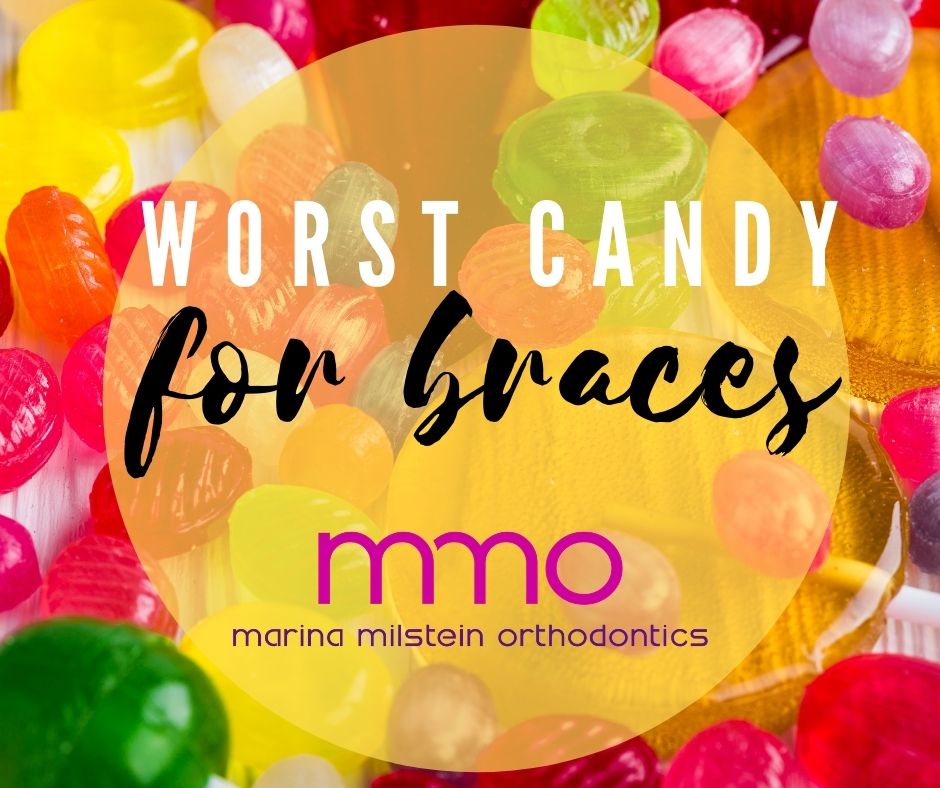November 1st, 2020

If you’re like most families in Granite Bay, you’ve probably got a giant stash of Halloween candy that will last you from now until Thanksgiving (if not Christmas.) And if you’re a parent who occasionally sneaks a piece from your child’s trick-or-treat bucket, here are some candies that could potentially be a hazard to orthodontic appliances or other dental work.
Worst Candy for Braces
A lot of candy is sticky or hard enough to break and pull braces off of teeth. If you’re not sure which ones you need to weed out or swap with something safer, here are some things to look for:
Jawbreakers or Other Hard Candy — It can be incredibly tempting to bite down into them. The pressure can pop brackets right off your teeth.
Sticky Caramel or Taffy — If it could get stuck to your hand, shirt, or a piece of furniture, it’s too sticky to eat with braces. But not only that, the sticky texture could pull out older restorations like fillings or crowns.
Homemade Popcorn Balls, Candy Apples, etc. — We know you love grandma’s recipe but wait until the braces finally come off before you give in to the temptation.
So, What Candy CAN You Eat?
Chocolate is one of the “least bad” types of sugary sweets you can indulge in over the holidays. Since it quickly melts in your mouth, your saliva naturally washes the residue away.
Milk chocolate and dark chocolate are excellent choices. If you opt for a candy bar with nuts, be careful not to bite down on it. Instead, break it into bite-size pieces and just let it melt on your tongue.
Broken Bracket? Call Our Granite Bay Orthodontist
Even if you stayed away from hard, sticky candy over Halloween, accidents happen. Call Marina Milstein Orthodontics today to schedule an appointment!
October 15th, 2020

A typical adult dentition (set of teeth) is made up of four different tooth types: incisors (front cutting teeth), canines (also called cuspids or “eye teeth”), bicuspids/premolars, and molars. The canine teeth have exceptionally long roots and are predominantly used for tearing firmer food textures. There are only four of these teeth, with one positioned at each corner of the mouth.
Unfortunately, sometimes those eye teeth can become wedged or impacted down inside of the bone and gums. When that happens, they tend to get caught against the adjacent teeth. They don’t erupt or may start to partially erupt quite high on the gum tissues (above your other teeth.)
Since canines are typically one of the last sets of teeth to erupt, you may not notice there’s a problem until your child is around 12 or 13 years old. In the meantime, you can watch for some of the following risk factors to prevent major orthodontic concerns as your child develops:
- A narrow arch shape
- Crowding in their other teeth
- Previously crowded baby teeth
- Premature loss of a baby tooth near that space
- A family history of impacted teeth
How We Can Help
Fortunately, there are ways to address impacted canine teeth and bring them back down into alignment with their neighbors. In the best-case scenario, an early orthodontic screening well before the eruption window can help you plan ahead. Depending on your child’s age and the development of their impacted cuspid, we can choose to uncover the tooth, allowing it to erupt normally, or affix an orthodontic appliance to it and guide it into place.
Granite Bay Impacted Tooth Treatments
Our experienced Granite Bay orthodontist has worked with numerous cases involving impacted canines over the years. We encourage you to book a brief consultation to learn more about how we can help!
September 1st, 2020

Orthodontic therapy is a process that takes advantage of your body’s natural growth patterns and anatomical characteristics. Since our Granite Bay patients get braces or aligners at various ages, the treatment is adapted to their unique situation. But sometimes, major tooth misalignment and growth concerns can be prevented before they start. The key is to intervene early, while the jaws and orofacial structures are still developing. We call this phase of orthodontic therapy “early interceptive orthodontics” or “Phase 1 Ortho.”
Interceptive orthodontics takes advantage of your child’s rapidly growing facial structures and developing smile to minimize issues like:
- Impacted teeth
- Crowding or gaps
- Overbites and underbites
- Overjets and underjets
- Crossbites
- Jaw irregularities
During interceptive orthodontics, Dr. Milstein adapts the therapy to guide your child’s developing teeth and jaws into a more anatomically correct position. By intervening early, future orthognathic surgeries or complex orthodontic treatment can potentially be eliminated or minimized.
Phase 1 Ortho
Interceptive orthodontics adapt your child’s developing smile for optimal health. Then, later on, the second phase of orthodontic appliances or aligners are used to fine-tune the bite (“Phase 2 Ortho”). Two phase treatments aren’t necessary for everyone, but they can be exceptionally useful when there are hereditary or growth pattern concerns.
The ideal time to initiate early interceptive orthodontics is usually no younger than age 7. At that point in a child’s development, Dr. Milstein can evaluate and predict growth patterns as they will affect your child’s future smile. Depending on the findings, Phase 1 braces may be recommended, or it could be best to monitor your child on a six-month to an annual basis.
Looking for an Experienced Orthodontist in Granite Bay?
Both the American Dental Association and the American Association of Orthodontists recommend that every child have an orthodontic exam by age 7.
Request a consultation at Marina Milstein Orthodontics today. We welcome patients of all ages!
June 18th, 2020

Getting braces often seems like a rite of passage for children and teens. Although not all kids need orthodontic treatment, experts and pediatric dentists recommend that each child should have bite assessments to screen them for possible orthodontic complications.
The American Association of Orthodontists and the American Dental Association suggest that parents should bring their child for an orthodontic evaluation by the time they’re 7 years old. At age 7, most kids have a combination of primary (baby) and permanent (adult) teeth, or what we call a “mixed dentition.” This stage of oral development is often crucial when it comes to where adult tooth placement and alignment fall into play.
Why do Kids Need Orthodontic Exams?
Early intervention can allow orthodontists like Dr. Milstein to guide adult teeth into proper placement and alignment or lessen the severity of issues so that they can be fine-tuned later on with the second phase of treatment.
Again, not every child needs braces, but catching issues earlier make orthodontic treatment more effective, less complex, and can even reduce the chances of surgery.
What Happens During the First Evaluation?
Depending on the exact age and oral development of your child, Dr. Milstein may simply examine their bite and oral anatomy, or also order a series of images or radiographs. Having visual data of tooth eruption patterns and seeing exactly how the teeth bite together can give you — as a parent or caregiver — the answers you need about your child’s future smile.
Be sure to let our Granite Bay orthodontist know if there are any underlying issues, such as speech problems, thumb sucking, or missing teeth that “run in the family.”
During your visit with Dr. Milstein, we’ll review any concerns, findings, and discuss what to expect in the future. We’re happy to answer any questions you may have. Request your consultation today!





 Website Powered by Sesame 24-7™
Website Powered by Sesame 24-7™